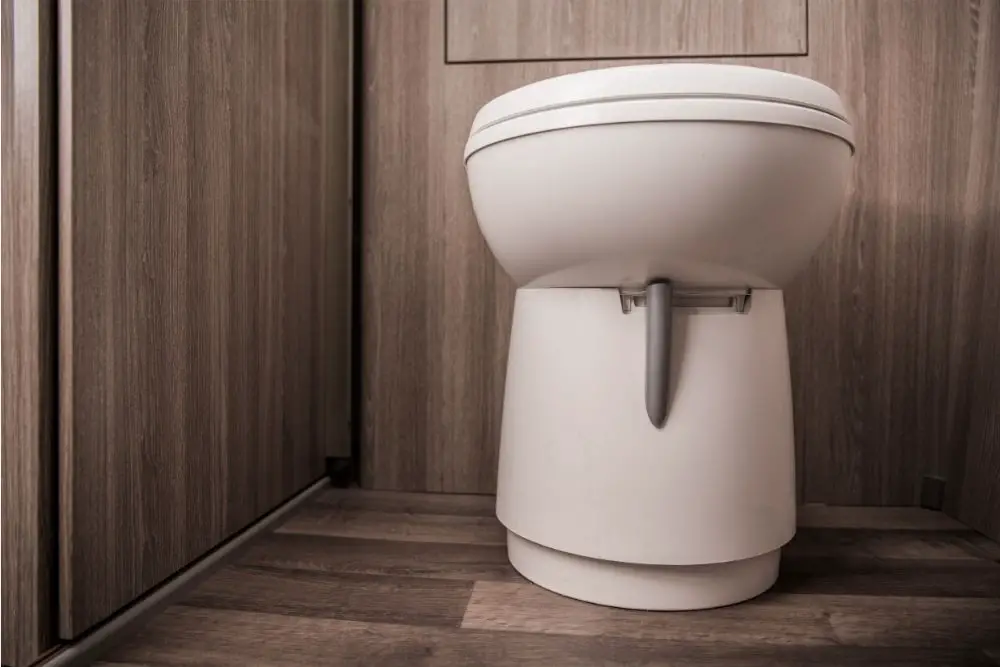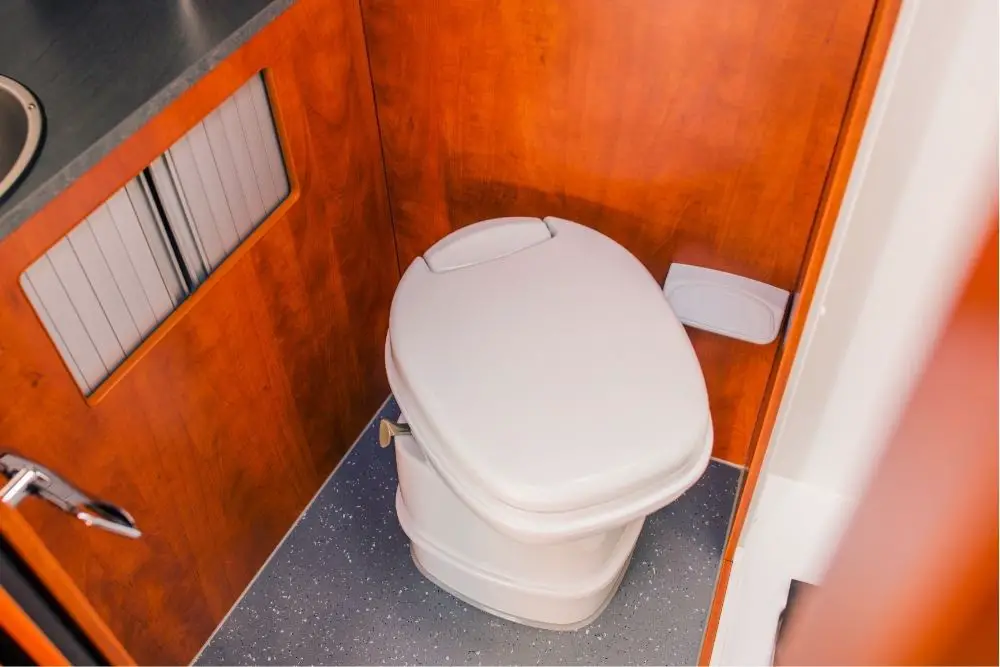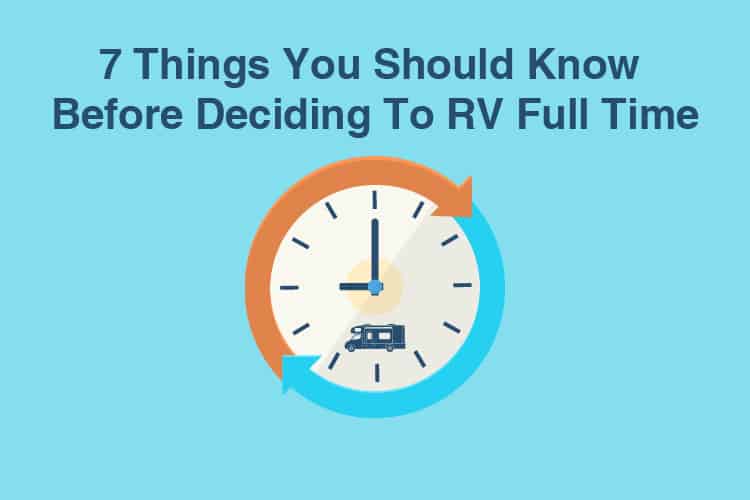If you spend a lot of time in your RV, you are more likely to experience one or two issues with the toilet. Full time RV owners will 100% know what we mean here. In any case, there are a plethora of reasons that your RV toilet could get clogged or backed up.
Toilets at home can get clogged up, but RV toilet systems are not quite as high-tech and there is every chance that you will experience one or two issues with them while you are out on the road.

One of the most common reasons you will experience this is called ‘pyramid plug’. Now, while it may seem likely that toilet back-ups in your home and your RV won’t be all that different. Sadly, this just is not the case, RV toilets have to be treated differently, like a toilet on a long-distance coach, or a train. It is not the same as a traditionally, static toilet’s plumbing.
Luckily though, there are several ways you can tackle a clogged RV toilet, and today we are going to tell you about most of them, the best ways at least anyway. We will focus, in detail, on how to unplug a pyramid plug as it is the most common plug in RV toilets.
So, there are 7 very easy steps that you can follow to unclog your RV toilet, or your Black Water Tank.
- First of all, close the black tank valve.
- Add water into the Tank.
- Then pour a bottle of holding tank cleaner into the tank.
- Let the cleaner sit for 12-27 hours.
- Open the valve to empty the tank.
- Then rinse the tank.
- And finally, close to black tank valve.
While today, we mainly want to discuss how to unclog a pyramid plug, we will also talk to you about some other methods that are great for a quick fix. Also, we want to give you some tips to prevent this problem happening in the future. Prevention is better than fixing, we can all agree on that!
We have loads of information for you, so, let’s get to it!
How do you unclog an RV toilet?
While it might sound like we are stating the obvious, anytime you have to unclog your toilet, or deal with any toilet issue, you have to do so with caution in mind. Although the method that we will focus on the most is the easiest method, as well as the most effective, there is still waste involved. SO, be careful!
Be sure to follow instructions to a ‘T’, and if you can, have someone with you to lend a helping hand. If you can unclog the toilet properly, then the waste will simply flow away into the sewer, and you can return to whatever you were doing before you noticed the clog.
However, before we jump into the steps, and the ways to unclog your toilet, we want to take a moment to talk to you a bit more about pyramid plugs.
The number one reason for an RV toilet to get clogged is from a build up of toilet paper and waste at the base of the black holding tank. The clog will begin where the tank drains off into the sewer, and it will gradually build up until it reaches the toilet.
It basically makes up a pyramid shape as it plugs the waste outlet of the tank. This is why it has this name.
So, keeping mindful of this, the tank itself is not actually clogged. However, there is a pyramid of toilet paper and waste blocking water from allowing the waste to leave the tank.
What do you need?
Hold on there. Before you get started at unclogging your toilet, you need to ensure you have the adequate materials to do this.
First of all, you definitely need to do this are;
- Disposable gloves.
- RV holding tank cleaner.
Since we are looking at the preferred method first, these materials needed are few. When you use and RV holding tank cleaner, you do not need to worry about using a plumbers snake. Using a snake can work really well, but it is often labor intense, and can get pretty messy. So, while this is an option, let’s check out the easier methods first.
The Unclogging
Tackling a pyramid plug does not have to be a daunting and difficult task. The number one thing that you have to remember when you are using an RV holding tank cleaner is time, these things take time to work properly and efficiently.
So, you may want to do this right before bed, so it has time to work overnight, or do it when you have access to another toilet for a day or so. Just ensure that it has time to work properly, when no one will use the toilet.
Using a holding tank cleaner
This is method number one, the easiest way to tackle this type of clog. Therefore, it is probably the thing you should try out first. Now, to go over the steps to doing this.
- First off, close your RV black tank valve to ensure that the cleaner has to sit with the plugged materials, and it cannot drain until the clog has been dissolved.
- Before you add in the cleaner, you want to add in a few extra gallons of water to the tank. Of course, you should only do this if there is room for this extra water. If you cannot add the water without it overflowing, then just skip this step. However, the more water you can add, the better your result will be. If you cannot add a few extra gallons, one gallon will do, just add as much as you can in if you cannot add a few extra gallons, it will help the process along.
- Pour a bottle of the holding tank cleaner into the tank through the toilet. And yes, use up the whole bottle. We aren’t joking.
- Next, it is time to leave the cleaner to sit for around 12-27 hours. The longer it sits in the tank the better. This type of holding tank cleaner will liquify the contents of the clog completely. So, the longer you leave it to sit in the tank, the more liquified it gets and the easier it will be to drain.
- Once the cleaner has done its magic, you can reopen the black tank valve to let the waste drain. Make sure that the tank empties entirely.
- Once the tank is emptied, clean up any remaining debris with a tank rinser. In many cases a tank rinser is the flush of a toilet, but not in every case. The rinsing process will usually take a good 20 minutes when it is done effectively.
- Now, close up the black tank valve once the rinse is complete. Keep the valve closed the majority of the time and only open it during dumping. Doing this prevents future pyramid plugs from occurring. Voilà, your problem is solved!
Always ensure that the cleaner you use is septic safe before you use it!
Nothing beats a good old plunger
If your obstruction is only minor then you can get away with the traditional method of using a good old toilet plunger.
This is usually the go-to choice when someone is attempting to clear a toilet, in RV’s or otherwise, as we are used to using them for our toilets at home.
Of course, this can work, it is not the most effective method out there. The suction of the plunger will only be sufficient if the clog is toward the surface of the toilet.
If the clog is deeper down the black water tank, then the plunger will not be able to resolve your issue. So, you can try a plunger, but if it doesn’t work, it is time to bring out the big guns.
A plumbers snake
If the clog is not too severe, but severe enough that your plunger cannot tackle it, you can use a flexible plumbers snake.
The downside of the method is that it can be rather messy. To use this method, you should have another person with you to help you out, and you will need some extra materials.
- A bendable plumbers snake.
- Eye protection gear.
- Disposable gloves.
- Disposable clothing.
- A bucket (preferably a medium-large one.)
Once you have all the above materials, you can proceed to get that clog out. These are the steps to take;
- Once you and your assisting person have pit on your protective gear, have one person go and place a bucket under the sewer aperture of the black water tank. The black water tank should be closed at this time s well, so they should do this too.
- Before you use the snake, try your best to drain any waste you can into the bucket by opening up the sewer tank and letting any waste fall into the bucket.
- Now this is done, the person with the snake can insert the snake into the clogged toilet. Push the snake through the piping until you feel as though the snake has hit the clog, it will be easy to tell.
- Once you have hit the clog, move the snake up and down to try and break the clog up until it falls into the black water tank. This might take some effort.
- Now, the person not manning the snake should close off the sewer valve.
- Connect the sewer hose to the outlet and the tank, then you can open the black water tank and let the waste drain into the sewer.
- Finally, empty the hose and bucket.
Boiling water
Similar to a tank cleaner, you can also use boiling water to assist in breaking up the materials that are causing your clog. The main reason that a RV toilet will clog is due to a lack of moisture in the tank. So, hot water will add the moisture that is needed to break these materials apart. Hot water is also best as it is more aggressive in liquifying waste.
In order to unclog your RV toilet with boiling water, you simply need to boil up some water and pour it into the toilet. Flush the toilet so that it enters the tank and then let it sit for a few hours.
Of course, alternatively, you can also pour the water directly into the tank itself. Yet, it does help if you have the water work its way through the whole system, for better results.
After a few hours if you still have a clog, repeat the process, but it may take a few tries depending on how big the clog is.
Ice cubes
Using ice cubes is very similar to the hot water method, it is just the opposite temperature. Some people will prefer this method over the hot water method. Generally, its usefulness does depend on the severity of the clog.
In order to unclog an RV toilet with ice cubes, all you need to do is fill up your toilet with water and as many ice cubes as you can to about ⅓ of the way. Then flush the toilet, and continue flushing as you drive your RV around. If the toilet is still clogged, add more water and ice cubes. Simple.
Take it to a dealership
If all these methods do not unclog your RV toilet, then you can always just take your RV to a dealership and get them to use a tank wand to spray the clog out.
They have high pressure tank wands that break up materials that will allow them to pass through. Most of the time, taking your RV into a dealership for a toilet unclogging fix will cost you around about $100 to $200.

How to tell if you have an issue with your RV toilet
A majority of signs that your RV toilet is clogged are rather obvious. That being said, there are some little signs that you can keep an eye out for too. Knowing when your toilet is close to clogging is ideal as you can catch the problem earlier on to prevent any severe clogs.
Let’s look at some of the signs, so you can catch them quickly.
- A sign of a clog, or approaching clog is if there is a powerful stench coming from the toilet, the black water tank, or the hose.
- You may not always be able to see a clog, however, smell will give it away. Distinct smells mean that something is not draining properly.
- If your black water tank valve is hard to open. And then, when you finally do open it, it does not seem to drain. This is another dead give away.
- If you go to drain your tank, and you do not see or hear anything happening, this is another sure sign.
- When you open the valve, the tank should drain. But if the tank isn’t empty after an attempt at draining, then there is a clog, tackle it right away.
Preventing backups
Prevention is better than fixing in any walk of life. Catching a clog early is good, but preventing any clogs from happening at all, that is even better.
You can do a few things in how you run your RV life and maintenance routines that will prevent you from ever having to deal with the unpleasantness of toilet clogs again.
Keep the black water tank valve shut
Briefly mentioned before, keeping your black water tank valve shut will help to prevent clogs. In fact, it is vital in preventing clogs, so we want to cover this in more detail.
Why does this prevent clogs? Well, the reason that keeping the valve closed on your black water tank is so vital is because when it is closed during its regular use, all the solid waste, toilet paper and water can mix and slosh about.
Okay, this does sound a bit disgusting, but as the liquids and solids mix, the liquid will break down the solids. This means that when you dump the tank out, they will all come out in a smooth and continuous flow. No chunks or clumps.
So, when you choose to leave the black water tank valve open during regular use, all the water and waste will flow out of the tank and into the sewer line. Water, and any liquid drains faster than solid do, which leaves the solid sitting in the tank, left behind by the faster moving liquids.
Since the tank is flat-bottomed, it is super easy for solids to get trapped there if there is not enough liquid to help them drain. So, as the toilet is used more, and more, more solids build up without any liquids to break them down into easier moveable pieces.
Eventually, there will be so many solids stuck at the bottom they will clog up the sewer line and block any waste from draining.
Extra water for the flush
So, if liquids are what you need to break down those pesky solids, surely having more water there can help, right? Correct. Water is what moves your waste and toilet paper through the tank and into the sewer.
This means that if you are not using the right amount of water in your flush, then your RV toilet will get clogged more often. You can always avoid this by flushing the toilet twice after each use.
The more water the better. As, if you use more water when you flush your RV toilet, then it will be easier for the materials to move and break down, therefore preventing any clogs.
So, the more water you use, the less of a chance you have that there will be a clog.
Use the right toilet paper
It might sound like teaching grandma to suck eggs, but using the correct toilet paper in your RV can be very important. If you do not use the right kind of toilet paper, you can be looking at some large problems.
You depend on the septic system, so, you need to ensure that whatever toilet paper you use is actually septic safe. To find this, you need to look for toilet paper that is labelled as ‘Septic safe’, or ‘certified safe 2-ply toilet paper’.
Thicker, and more expensive toilet papers will not work in an RV septic system, so chances are you cannot use the same toilet paper you use at home.
Thicker and more expensive toilet paper will have to take longer to break down, so you need your toilet paper to be thin enough to break down quickly with water.
Also, it is wise to avoid flushable wipes, if you do use wipes, then dispose of them in the garbage, not the toilet, this is a general rule, and one you should apply when in your home as well, as few wipes are toilet safe.
Drop-in RV toilet cleaners
You can also get chemical drop cleaners that you can use in your kitchen and your bathroom. Again, you need to ensure that your drop-in cleaners are septic safe. Since there are so many types of these drop in cleaners available on the market, you must be sure that they will be safe for your septic tank.
There are certain cleaners such as tissue digesters, blue max drops, or a probe cleaner that will do exactly what you need in your RV bathroom. Depending on which cleaner you purchase, the frequency of which you must use it will vary. Ensure that whatever you use, you read the instructions carefully and only use it as the directions specify.
Toilet and Black Water Tank Maintenance
One of the best ways to skip out on any annoying clogs in your toilet, is to simply perform regular RV toilet maintenance. And it is not all that different to how you would maintain your bathroom in your home.
This regular maintenance should always involve a check schedule as well as certain cleaning tasks that you should perform every month, and then every year. However, the frequency with which you perform these maintenance tasks depend on how often you use your RV.
For example, if you are a full-time RV owner, then you need to do these maintenance tasks much more often, much like a typical homeowner may do a bathroom clean once a week.
The best thing that you can do is ensure that you fully drain and clean your black water tank often. Doing this will give you a boost on any clogs, notifying you early, and allowing you to pick up on any symptoms, or forebodings of an approaching clog, so you can tackle and resolve the issue before it becomes a bigger issue.
You can also choose to use the RV holding tank cleaner that we mentioned at the beginning of this article. Use it once a year when you winterize your RV to make sure that everything is completely cleared out and ready for use, and the approaching winter months.
Frequently Asked Questions
Can you use Drano in an RV toilet?
Drano might seem like a good idea, like something that might unclog an RV toilet well, but it isn’t recommended you do so. Cleaners such as Drano are caustic, and they can actually harm the plumbing of your RV.
If you use these cleaners often it will end up breaking down and destroying the pipes and seals which will just make everything worse. You should only use cleaners that are labelled and confirmed for RV use, and that they are classified as being septic safe.
How exactly do I empty my black water tank?
We are glad you asked, knowing how to do this is imperative for avoiding clogs and getting rid of clogs. So, here are stop steps to help you out.
- Attach the sewer hose to the dump station hole and the other end to your black water tank.
- Next, open the tank valve and let the tank drain. It may tank a little while.
- Once the tank seems to have completely emptied, close the valve and remove the connector. Be sure to do this slowly, you want to avoid any mess.
- Finally, close the black water tank valve.
It really is that simple. It can be a bit easier if you use a clear connector to attach the sewage hose to the black water tank. This way you can actually see what is coming out, and you do not need to rely on sound alone, or make any guesses. Even if it does look rather unpleasant.




